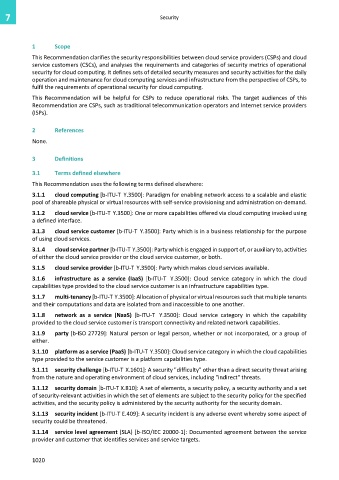Page 1028 - Cloud computing: From paradigm to operation
P. 1028
7 Security
1 Scope
This Recommendation clarifies the security responsibilities between cloud service providers (CSPs) and cloud
service customers (CSCs), and analyses the requirements and categories of security metrics of operational
security for cloud computing. It defines sets of detailed security measures and security activities for the daily
operation and maintenance for cloud computing services and infrastructure from the perspective of CSPs, to
fulfil the requirements of operational security for cloud computing.
This Recommendation will be helpful for CSPs to reduce operational risks. The target audiences of this
Recommendation are CSPs, such as traditional telecommunication operators and Internet service providers
(ISPs).
2 References
None.
3 Definitions
3.1 Terms defined elsewhere
This Recommendation uses the following terms defined elsewhere:
3.1.1 cloud computing [b-ITU-T Y.3500]: Paradigm for enabling network access to a scalable and elastic
pool of shareable physical or virtual resources with self-service provisioning and administration on-demand.
3.1.2 cloud service [b-ITU-T Y.3500]: One or more capabilities offered via cloud computing invoked using
a defined interface.
3.1.3 cloud service customer [b-ITU-T Y.3500]: Party which is in a business relationship for the purpose
of using cloud services.
3.1.4 cloud service partner [b-ITU-T Y.3500]: Party which is engaged in support of, or auxiliary to, activities
of either the cloud service provider or the cloud service customer, or both.
3.1.5 cloud service provider [b-ITU-T Y.3500]: Party which makes cloud services available.
3.1.6 infrastructure as a service (IaaS) [b-ITU-T Y.3500]: Cloud service category in which the cloud
capabilities type provided to the cloud service customer is an infrastructure capabilities type.
3.1.7 multi-tenancy [b-ITU-T Y.3500]: Allocation of physical or virtual resources such that multiple tenants
and their computations and data are isolated from and inaccessible to one another.
3.1.8 network as a service (NaaS) [b-ITU-T Y.3500]: Cloud service category in which the capability
provided to the cloud service customer is transport connectivity and related network capabilities.
3.1.9 party [b-ISO 27729]: Natural person or legal person, whether or not incorporated, or a group of
either.
3.1.10 platform as a service (PaaS) [b-ITU-T Y.3500]: Cloud service category in which the cloud capabilities
type provided to the service customer is a platform capabilities type.
3.1.11 security challenge [b-ITU-T X.1601]: A security "difficulty" other than a direct security threat arising
from the nature and operating environment of cloud services, including "indirect" threats.
3.1.12 security domain [b-ITU-T X.810]: A set of elements, a security policy, a security authority and a set
of security-relevant activities in which the set of elements are subject to the security policy for the specified
activities, and the security policy is administered by the security authority for the security domain.
3.1.13 security incident [b-ITU-T E.409]: A security incident is any adverse event whereby some aspect of
security could be threatened.
3.1.14 service level agreement (SLA) [b-ISO/IEC 20000-1]: Documented agreement between the service
provider and customer that identifies services and service targets.
1020

